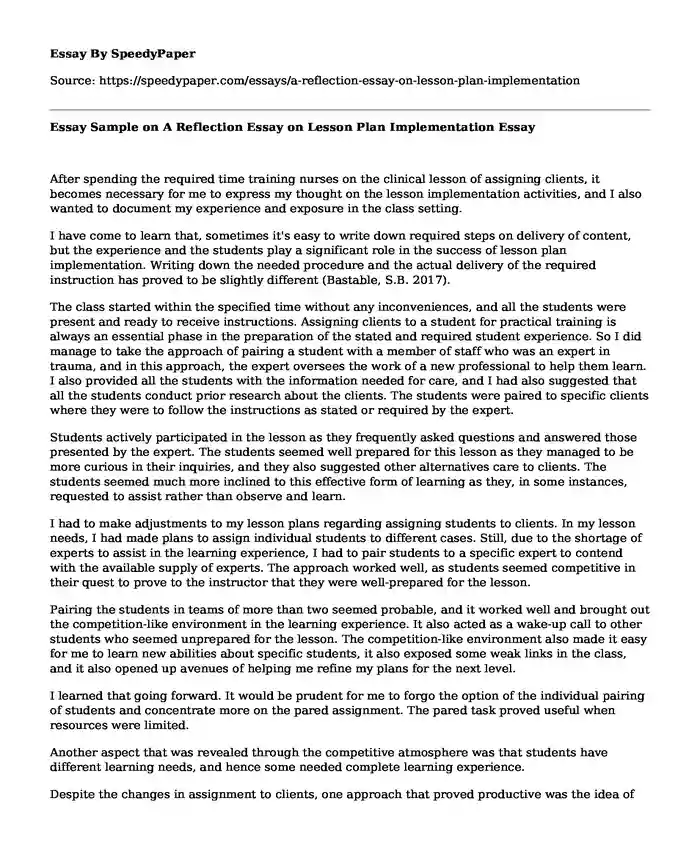
| Essay type: | Reflective essays |
| Categories: | University Teaching Learning Medicine |
| Pages: | 3 |
| Wordcount: | 743 words |
After spending the required time training nurses on the clinical lesson of assigning clients, it becomes necessary for me to express my thought on the lesson implementation activities, and I also wanted to document my experience and exposure in the class setting.
I have come to learn that, sometimes it's easy to write down required steps on delivery of content, but the experience and the students play a significant role in the success of lesson plan implementation. Writing down the needed procedure and the actual delivery of the required instruction has proved to be slightly different (Bastable, S.B. 2017).
The class started within the specified time without any inconveniences, and all the students were present and ready to receive instructions. Assigning clients to a student for practical training is always an essential phase in the preparation of the stated and required student experience. So I did manage to take the approach of pairing a student with a member of staff who was an expert in trauma, and in this approach, the expert oversees the work of a new professional to help them learn. I also provided all the students with the information needed for care, and I had also suggested that all the students conduct prior research about the clients. The students were paired to specific clients where they were to follow the instructions as stated or required by the expert.
Students actively participated in the lesson as they frequently asked questions and answered those presented by the expert. The students seemed well prepared for this lesson as they managed to be more curious in their inquiries, and they also suggested other alternatives care to clients. The students seemed much more inclined to this effective form of learning as they, in some instances, requested to assist rather than observe and learn.
I had to make adjustments to my lesson plans regarding assigning students to clients. In my lesson needs, I had made plans to assign individual students to different cases. Still, due to the shortage of experts to assist in the learning experience, I had to pair students to a specific expert to contend with the available supply of experts. The approach worked well, as students seemed competitive in their quest to prove to the instructor that they were well-prepared for the lesson.
Pairing the students in teams of more than two seemed probable, and it worked well and brought out the competition-like environment in the learning experience. It also acted as a wake-up call to other students who seemed unprepared for the lesson. The competition-like environment also made it easy for me to learn new abilities about specific students, it also exposed some weak links in the class, and it also opened up avenues of helping me refine my plans for the next level.
I learned that going forward. It would be prudent for me to forgo the option of the individual pairing of students and concentrate more on the pared assignment. The pared task proved useful when resources were limited.
Another aspect that was revealed through the competitive atmosphere was that students have different learning needs, and hence some needed complete learning experience.
Despite the changes in assignment to clients, one approach that proved productive was the idea of giving the students prior information about the patients and the plans of a care unit. To enforce the information provided, I had asked students to formulate a game, more like a treasure hunt so that they can establish definitively where certain items needed in work, were placed and which member of stuff they needed to see for particular items. This game helped many of them to answer questions correctly, and it helped them demonstrate their knowledge base on hospital operations.
In conclusion, I learned that the students enjoyed working in this kind of environment more than the classroom, where it was about reading and learning theories. They appreciated the opportunity to meet their role models and participate in an actual hospital meeting actual patients. I hope shortly we can make our lessons more practical in all dimensions and expose our students to real-life situations as a way to prepare them for their careers.
References
Bastable,S.B.(2017).Nurse as educators: Principle of teaching and learning for nursing practice.Jones & Bartlett Learning
https://journals.lww.com/nepolinei/Citation/2003/03000/Nurse_as_Educator_Principle_of_Teaching_and.14.aspx
Bradshaw M.J..,&Hultquist, B.L.(2016).Innovative teaching strategies in nursing and related health professionals. Jones & Bartlett Learning
https://books.google.co.ke/books?id=aLH77WXH5JIC&printsec=frontcover#v=onepage&q&f=false
Hofmeyer,A...,Toffoli,L.,Vernon,R.,Taylor,R.,Klopper,H.C,Coetzee,S.K.,& Fontaine,D.(2018).Teaching compassionate care to nursing students in a digital learning and teaching environments. Collegian 25(3)307-312 https://doi.org/10.1016/?j.colegn.2017.08.001
Cite this page
Essay Sample on A Reflection Essay on Lesson Plan Implementation. (2023, Jul 12). Retrieved from https://speedypaper.net/essays/a-reflection-essay-on-lesson-plan-implementation
Request Removal
If you are the original author of this essay and no longer wish to have it published on the SpeedyPaper website, please click below to request its removal:
- Free Essay: The Relationship Between Infection Levels and Polymorphisms
- Chinese Education System - Free Essay for Everyone
- Measures That India and China Have Taken to Battle HIV/AIDS, Free Essay
- Essay Sample on Childhood - Growing Up
- Echinacea - Free Essay Sample
- Politics, Patient Protection, and Affordable Care Act Discussion - Paper Example
- Nursing: Nursing Informatics in Health Care - Essay Sample
Popular categories




